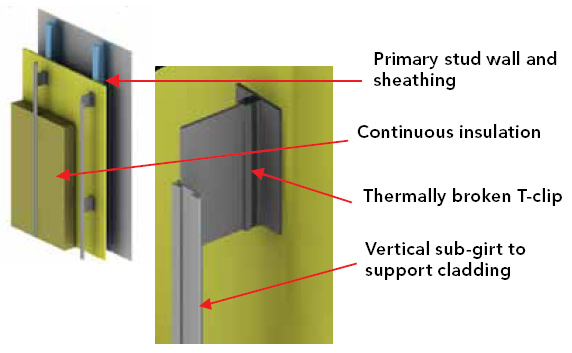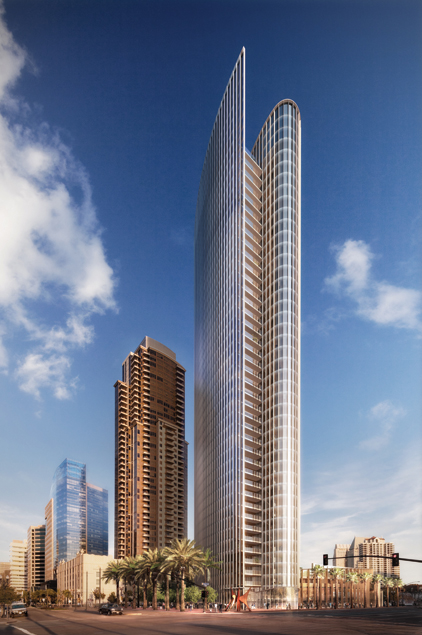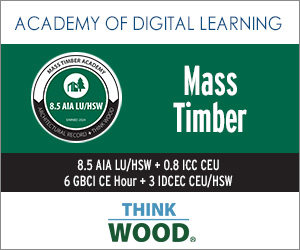Innovations in Aluminum Cladding Systems
Aluminum Back-Framing Systems

Image courtesy of Longboard – a division of Mayne Coatings Corp.
An aluminum back-framing system secures aluminum cladding to the primary wall while providing a space for continuous insulation to be inserted.
Combining the need for energy efficiency and the benefits of aluminum has led to an interest in finding ways to use aluminum exterior cladding or ventilated rainscreens over continuous insulation. The challenge of course is how to secure the exterior cladding without compromising the continuous insulation with fasteners and supports. An innovative solution can be found in aluminum “back-framing” systems that can secure the metal cladding to the primary wall with minimal disruption to standard insulation products. Such a system also needs to contain its own thermal break to avoid adding thermal bridges through the fasteners to the wall assembly. Back-framing systems that incorporate thermally broken aluminum clips for attaching aluminum cladding to the primary wall assembly and integrate continuous insulation offer the best potential to boost building energy performance and occupant comfort. Offering the most flexibility are framing systems designed for non-combustible mid- and high-rise building envelopes whether the primary walls are steel framing, stud walls, block, or concrete. Similarly, systems that can accommodate different continuous insulation thicknesses, generally 3, 4, 5, and 6 inches, offer more options to optimize energy performance.
In order to evaluate the thermal performance and wind load resistance of such a back-framed system, the independent testing laboratory Morrison Hershfield has tested such a system on various types of backup or primary walls. Performance of this system was validated through modeling and the finite element analysis (FEA). The tested system consists of a thermally broken aluminum T-clip and an extruded aluminum sub-girt for attaching rainscreen cladding systems to the primary walls. The aluminum T-clips are fastened directly to the primary wall at a spacing that can match wall framing or to accommodate standard widths of continuous insulation products (i.e. 2-feet-0-inch on center). The T-clips project out horizontally from the wall and include a thermal break in the base to thwart thermal bridging between the wall and the clip. The depth of the T-clip is equal to the depth of the continuous insulation used. Along the outside end of the T-clip, thin sub-girts are fastened to run vertically so they are parallel to the wall. These sub-girts in turn support aluminum cladding or rainscreen panels.

Photo courtesy of Longboard – a division of Mayne Coatings Corp.
Morrison Hershfield tested an aluminum back-frame system that allowed for different thicknesses of continuous insulation and was suitable for a variety of different primary wall types.
The Morrison Hershfield engineer's report included structural analysis for dead loads and wind loads on the entire system, including fasteners, clips, sub-girts, and the cladding. Clip spacing was examined with clip attachment assumed to connect to an 18-gauge stud (minimum) using two screws attaching the clip to the stud plus one screw attaching the sub-girt to each clip. The clip analysis was based on using cladding with a dead load of 1.5 pounds per square foot. The system was further analyzed using different types and thicknesses of continuous insulation.
Some of the key findings of the Morrison Hershfield report included the following:
• The back-framing system meets the prescriptive requirements in ASHRAE 90.1 – 2007/2010 for all climate zones for non-residential steel stud walls through the effective use of continuous insulation.
• The system is appropriately designed for mid and high-rise (non-combustible) building envelopes.
• Wind load resistance up to 70 psf is possible.
• A comprehensive rainscreen solution is provided in the system.
• The back-framing system is suitable for use with all types of primary wall systems including steel stud, wood stud, masonry, and concrete.
Overall, the Morrison Hershfield study suggests that this type of back-frame system performs very well in the context of meeting code requirements for structure, fire, and energy performance.
Wall and Soffit Cladding Materials
Wall cladding is typically referred to as a decorative covering intended to achieve an overall aesthetic appearance that an architect, designer, or owner has in mind. Some of the most common examples are on the outside of buildings, but cladding can also be an artistic element on interior locations. It's usually non-structural, which means that it doesn't impact the stability or integrity of a building's structural system. It is intended to be the permanent weathering and wearing surface of a wall. A variation is rainscreen cladding which anticipates and is designed for some air flow behind the cladding in order to allow any moisture or rain water to freely drain away. Either way, cladding can be made out of almost any material including various metals, stone, composite materials, and others.
One type of cladding is simply referred to as siding, particularly on residential buildings. Siding is the exterior material on building walls that protects them from the elements, usually by shedding or deflecting rain and weather away. Before World War II, wood siding was the most commonly used type in residential construction. While the beauty and warmth of natural wood has been and still is highly regarded, wood can have drawbacks. According to the International Association of Certified Home Inspectors, wood requires higher maintenance than many other building materials and is subject to regular repainting or resealing as often as every two to three years. If wood is not well maintained, deterioration may occur which, in turn, can compromise the integrity of a building. Further, wood is a hygroscopic material in that it takes in and gives off water to balance with its environment. If exposed to a high-moisture environment, wood can become subject to decay over time. Pests such as termites are another factor that may be damaging to wood, though that potential can be reduced by the selection of the wood species itself, by preservatives, or by other treatments. Cost is another consideration, with wood among the most expensive cladding materials on the market.
In the post WWII era, as metal was more available, aluminum siding was increasingly used successfully on many homes as a more durable, lower maintenance choice compared to wood. Other materials have since entered the residential market including vinyl and composite siding materials, each with their own particular attributes, strengths, and weaknesses. Meanwhile, aluminum use for cladding has expanded notably into the commercial sector bringing all of the attributes and characteristics of the material to virtually all building types.










